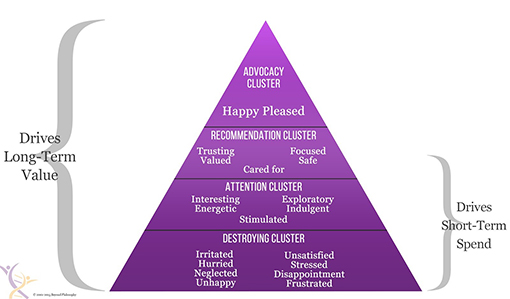Your customers are not as rational as you think they are. In fact, you are not as rational as you think you are. You, like your customers, are an irrational human whose emotions drive your decision-making most of the time.
Even if this statement affronts you a bit, you likely realise that I am right. Our emotions tell us what car to buy, which utility to use, and where to go on vacation. They help us sort through all the options and make a decision that we are…wait for it… happy with.
So if we know this to be the case, why is that when it comes to customer loyalty and retention, most organisations want to appeal to their customers’ rational side? We have been Customer Experience consultants for well over a decade now, and we know that rationality has less to do with either of these vital concepts than you think.
We say it all the time; over 50% of how customers perceive their customer experience has to do with the emotions they feel. Therefore, earning a customer’s loyalty means you must embrace their emotional side. Moreover, you must be deliberate about which emotions you embrace. The goal is to create a customer experience that has a deliberate emotional outcome that drives value for your organisation, which in this case is customer retention and loyalty.
Maybe you are on board with this idea of a deliberate emotional outcome already and ready to embrace it straight away. Great. However, it is at this point, in my experience, that many people start asking some crucial questions, which might include the following:
- Which emotions should the customer experience evoke?
- What do you do to evoke emotions deliberately?
- How do you know if it’s working?
These are all excellent questions. Let’s address each in turn:
Which emotions should the customer experience evoke?
Before we answer this question, you have to believe that emotions are the key motivators behind people’s behaviour. If you have doubts about the validity of this statement, then I have some research that might help. We worked with the London School of Business in preparation for our third book, The DNA of Customer Experience: How Emotions Drive Value (Palgrave Macmillan, 2007), we undertook 18 months of research to prove exactly this concept. After sorting through responses from over 50,000 people that answered over a million questions about what they want and how they felt, we narrowed the spectrum of emotions down to the 20 emotions that either drive or destroy value for a customer experience. They are:

Therefore, to answer your questions about whether emotions drive people’s behaviour, we suggest you read the book. For those of you that believe me already, you can see that evoking any of the emotions outside of the “destroying cluster” is a good start.
As part of this exercise, we developed what we call the Emotional Signature, which measures the emotional engagement a customer feels with your organisation. We recommend determining what your Emotional Signature is now so that you can then see what you need to change to make it what you want it to be.
What do you do to evoke emotions deliberately?
Emotions make many people in business uncomfortable. Why? They don’t feel businesslike. We were all raised with the words, “It’s not personal; it’s business,” and emotions feel, well, personal, don’t they? Moreover, many organisations think they have no control over how a customer feels in their experience. Because they feel this way, they choose to create an experience that is both rational and efficient. Unfortunately, it is typically rational and efficient from an operations standpoint rather than a customer’s. They are essentially taking an inside-out approach to creating a customer experience, meaning they are looking at it from an insider’s point of view rather than an outsider’s.
Evoking emotions deliberately requires an Outside-In Approach. You must look at the experience the way a customer would. When you do, you discover how each moment in your experience makes you feel, an invaluable level of awareness. It is this awareness of the impact of different moments that identifies how you can evoke a particular emotion.
The Norwich Group in the UK explains it well in this short video.
How do you know if it’s working?
Measuring your success is a critical element of your evoking a deliberate emotional outcome with your customer experience. In our Customer Experience consultancy, we typically advocate using the Net Promoter Score (NPS), and the higher the NPS, the better! Why? Customers with a high NPS spend more than those with lower scores and are less sensitive to price, facilitating higher margins. But perhaps best of all, they are responsible for the “word of mouth” referrals, the gold standard of customer loyalty. Therefore, tracking the increase in your NPS is the best metric to determine if it’s working.
Are you ready to embrace your customers’ emotional side?
If we can be rational for a minute, it’s important to understand that the emotions you evoke in your customer experience have a significant influence on your ability to build customer loyalty and retention. Recognising this fact, knowing what emotions you want to evoke, seeing where to do it, and measuring your results are key to achieving your goals.
We are all irrational to our core and as customers use our emotions to guide important buying decisions. Appealing to this irrational side is critical to creating a deliberate emotional outcome that drives up the NPS—and those margins a high NPS creates.
The question is, are you ready to embrace this emotional side? I hope so, because it’s the only rational thing to do.

Thanks to Colin Shaw who is the founder and CEO of Beyond Philosophy, one of the world’s first organisations devoted to customer experience.
Colin is an international author of five bestselling books and an engaging keynote speaker.
Colin’s sixth book, “The Intuitive Customer: 7 imperatives to move your Customer Experience to the next level (Palgrave Macmillan, 2016) will be out next month. To learn more, click here.
Author: Rachael Trickey
Published On: 24th Aug 2016 - Last modified: 15th Aug 2025
Read more about - Customer Service Strategy, Customer Experience (CX), Editor's Picks, Service Strategy








































